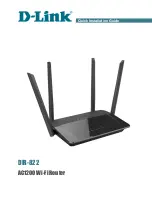
51
ATM is a connection oriented packet switching technology using fixed size packets,
called cells. These cells consist of a header and a payload and are switched
through a public or private ATM network depending on the contents of the header.
End-to-end connections are formed by cross connecting individual ATM segments
in ATM switches. Each ATM cell carries two labels called Virtual Path Identifier
(VPI) and Virtual Channel Identifier (VCI) as part of its header.
An ATM channel, commonly referred to as Virtual Channel, is fully identified by
these two labels. Therefore, multiple ATM channels can reside on your DSL line.
All ATM connections are static, i.e. of type Permanent Virtual Channel (PVC).
7.5.2. ATM traffic handling
ATM traffic at SP3353 is switched to the Ethernet port. Inside ATM VCs any
protocol can be transported. However, at both endpoints (the ATM channels are
terminated), the same protocol must be supported. If not, there will be no
end-to-end connectivity. Only frames recognized/ supported by SP3353 on a
particular ATM connection are extracted, or encapsulated.
Currently the supported encapsulations are:
(1) Transparently Bridged connections – RFC 1483, Ethernet V2.0/IEEE 802.3
bridged PDUs for both the LLC/SNAP method and VC-MUX method
(2) Bridged PPPoE connections – RFC 1483, Ethernet V2.0/IEEE 802.3 bridged
PDUs for bothe the LLC/SNAP method and VC-MUX method
(3) PPPoA-to-PPTP Relaying connections – RFC 2364, PPP PDUs for both the
LLC/NLPID method and VC-MUX method.
The default VCs can be remotely modified via the AutoPVC feature. AutoPVC
operated only when your ISP supports this function. SP3353 supports this function.
You can enable the function by only checking the radio box.
















































